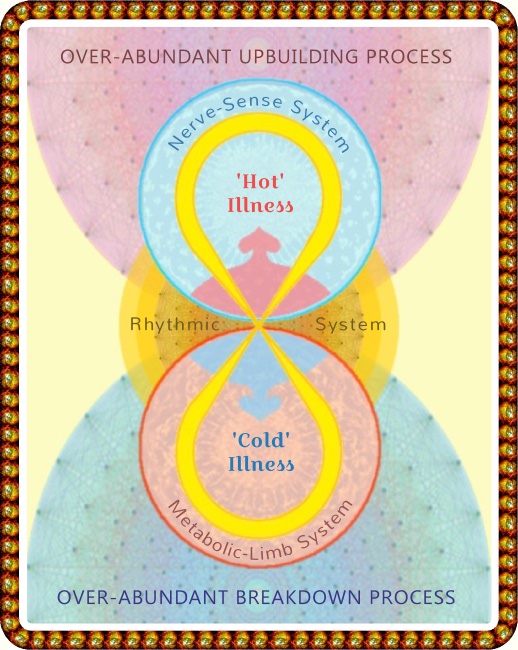How a Healthy Metabolic Process Turns Into an Illness
When we look at the THREEFOLD HUMAN BEING we can see that
nerve-sense system is concentrated in the head; its main organ is the brain.
For proper functioning of our mental activities the brain needs to be
physically at rest and relatively cold. [1] The
metabolic-limb system is much more physically active and it warms our body
up when we move or work. The proper balance between these two polar
activities is held by the rhythmical activities of the chest – that is, by
breathing and the rhythm of blood circulation.
But there is another, more hidden polarity between these two systems.
"Within the human organism there is basically a continuous interaction
between the breakdown processes, the deadening processes, and the upbuilding
processes, the growth or proliferative processes. The human organization
cannot be grasped without this activity.
What is actually present there, however? If the breakdown process of the
nerve-sense organization works into the metabolic-limb system through
rhythm, something is present there that works against the metabolic-limb
system, something that is a poison for this metabolic-limb system. The
reverse is also the case, that what is present in the upbuilding system,
working into the head system in rhythm, is a poison for the head system. And
since the systems are spread out over the entire organism, a poisoning and
unpoisoning are continuously taking place everywhere in the human organism,
and this is brought into balance by the rhythmic processes.
We are therefore unable to regard such a natural process – as taking
its course in the organism – one-sidedly, in the way that one normally pictures things,
so that healthy processes are simply designated as normal. Rather we
look into two processes working against one another, where one is a
process that is thoroughly illness-engendering for the other. We simply
cannot live in the physical organism at all without continuously
exposing our metabolic-limb system to the causes of illness from the
head system and exposing the head system to the causes of illness from
the metabolic system. A scale that is not balanced properly is thrown
out of balance by entirely natural laws so that the beam does not rest
on the horizontal; similarly life, because it is in constant movement
within itself, does not simply exist in a state of balanced rest but
rather exists in a state of balance that can deviate in both directions
toward irregularities.
Healing, then, means simply that if the head system, for example, is
working in a way too strongly poisonous on the metabolic system,
its poisoning effect is relieved; its poisonous effect is
taken away. If, on the other hand, the metabolic-limb system is working
in a way too strongly poisonous on the head system, which means working
over-abundantly, then its poisonous effect must also be removed."
[2]
One of the basic characteristics of anthroposophical medicine is
its approach to diagnosis and therapy, based on the polarity of
sclerotic and inflammatory illnesses. "An unhealthy excess of the
activity of the metabolic-limb system is characterised by an increase in
warmth and an excess of fluid (swelling) – the essential features of
fever and inflammation. An unhealthy excess of the nerve-sense activity
is characterised by a loss of fluid, excessive hardening, a loss of
mobility and flexibility, and a build-up of mineral deposits in the
body. These are the features of degenerative or sclerotic illnesses,
such as osteoarthritis or arteriosclerosis." [3]
'Hot' illness is therefore caused when an upbuilding activity that
prospers in the warmth environment of the metabolic-limb system
oversteps its proper boundary or appropriate intensity, often causing us
to become literally too hot. And 'cold' illness is caused when a
disintegrating activity that prospers in the relatively cold environment
of the nerve-sense system oversteps its proper boundary or appropriate
intensity, often causing stiffening of a part of our organism which
should be kept in a flexible condition – an equivalent of the result of
the cold on a living organism.
Of course, we need to take into account that the human being with
his organism is an extremely complex being and therefore we can also
find illnesses which are due to various combinations of excesses
originating either in the upper (cold) system, or in the lower (warm)
system, or in both.


